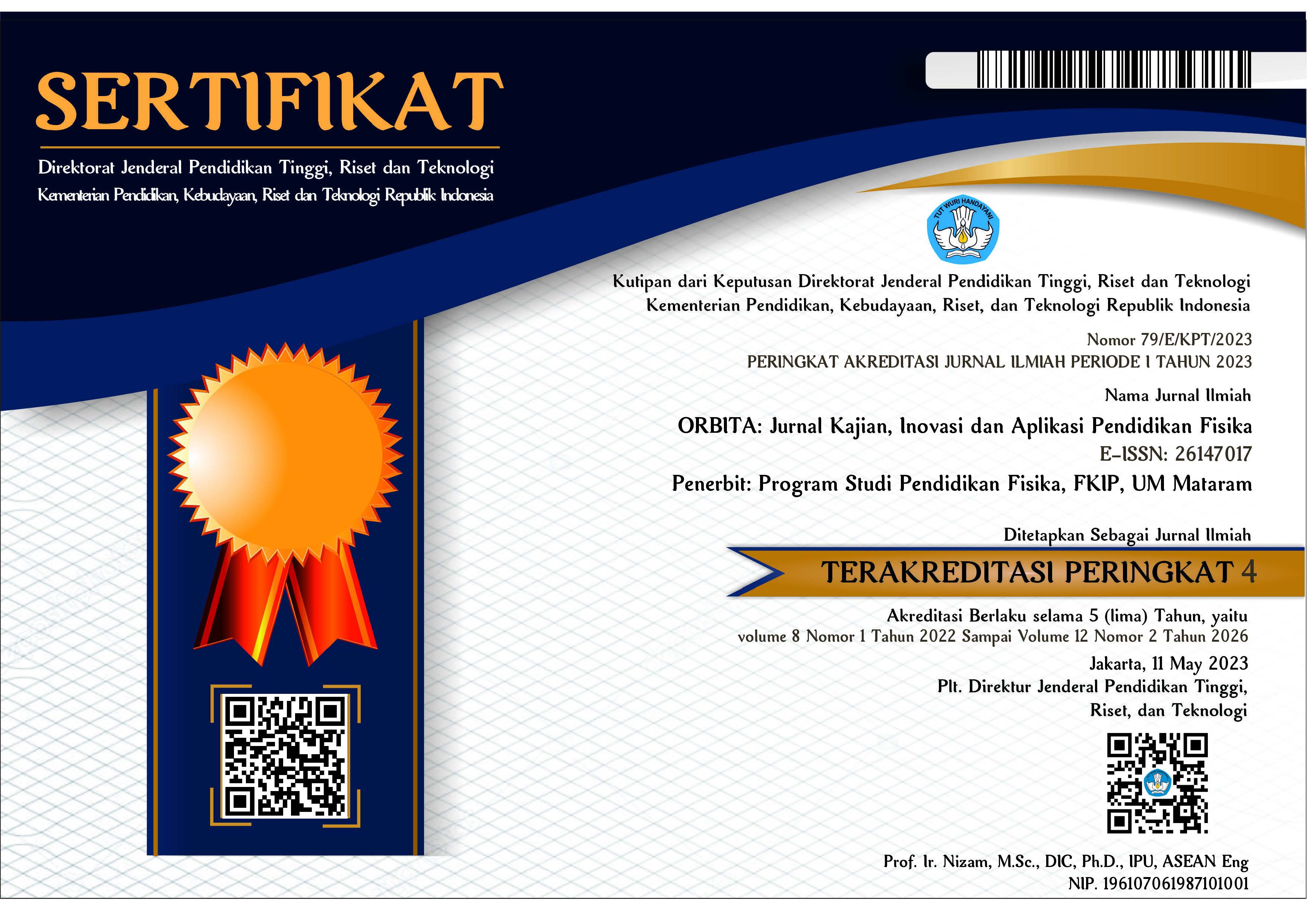SINTESIS PAPAN KOMPOSIT BERBAHAN DASAR SERAT SABUT KELAPA DAN SERAT BUAH KETAPANG DENGAN MATRIK PVAc
Abstract
ABSTRAK
Sintesis komposit mengggunakan campuran serat sabut kelapa dan serat buah ketapang dengan matrik Polyvinil Acetat (PVAc) telah berhasil dilakukan. Sampel tersebut dibuat dengan variasi komposisi fraksi volume serat sabut kelapa dan serat buah ketapang yaitu (0:100), (30:70), (40:60), (50:50), (60:40), (70:30) dan (100:0)%. Perbandingan fraksi volume campuran serat alami dan matrik polyvinyl Acetat (PVAc) yang dibuat yaitu (70:30)%. Pembuatan sampel diawali dengan pengambilan serat sabut kelapa dan buah ketapang, penjemuran dan pemotongan, kemudian pencampuran serat sabut kelapa dan serat buah ketapang dengan matriks PVAc, pencetakan komposit dengan alat cetak tekan dan penjemuran. Sampel yang sudah jadi selanjutnya diuji fisiknya dengan cara menentukan nilai massa jenis dan kadar air sampel untuk melihat kualitas sampel. Hasil penelitian menunjukan bahwa secara keseluruhan sampel telihat homogen, massa jenis sampel berkisar antara 0,52- 0,72 gram/cm3 dan nilai kadar air berkisar antara 10,05- 12,89%. Hal ini berarti bahwa sampel komposit telah memenuhi kriteria SNI 03-02105-2006 dan termasuk pada katagori berkerapatan sedang.
Kata kunci: komposit; serat sabut kelapa; serat buah ketapang; PVAc.
ABSTRACT
Synthesis using a mixture of Coconut coir fiber and Terminalia catappa fruit fiber with the Polyvinyl Acetate (PVAc) matrix has been successfully carried out. The samples were made with variations in the composition of the volume fraction of Coconut coir fiber and Terminalia catappa fruit fiber, namely (0: 100), (30:70), (40:60), (50:50), (60:40), (70:30) ) and (100: 0)%. The ratio of the volume fraction of the mixture of natural fibers and the polyvinyl acetate (PVAc) matrix made was (70:30)%. The sample production begins with taking Coconut coir and Terminalia catappa fruit, drying and cutting, then mixing coconut coir and Terminalia catappa fruit fiber with a PVAc matrix, molding the composites using a press printing tool and drying. The finished sample is then physically tested by determining the density value and moisture content of the sample to see the quality of the sample. The results showed that the overall sample looked homogeneous, the density of the sample ranged from 0.52 to 0.72 grams/cm3 and the moisture content ranged from 10.05 to 12.89%. This means that the composite sample has met the SNI 03-02105-2006 criteria and is included in the medium density category.
Keywords: composite; coconut coir fiber; terminalia catappa fruit fiber; PVAc.
Keywords
Full Text:
PDFReferences
Ardanuy, M., Claramunt, J., & Toledo Filho, R. D. (2015). Cellulosic fiber reinforced cement-based composites: A review of recent research. In Construction and Building Materials. https://doi.org/10.1016/j.conbuildmat.2015.01.035
Dahlan, I., Doyan, A., & Kosim. (2018). Tensile Test of Terminalia Catappa Fruit Fiber Composite Material. IOSR Journal of Applied Physics (IOSR-JAP). DOI: 10.9790/4861 - 1003026367.
De Oliveira, W. L., Xavier, A. A. B., Chaves, R. C. F., De Souza, P. M., Silva, L. O., & Fabri, É. S. (2018). ANALYSIS OF THERMAL ABSORPTION FROM COMPOSITE PRODUCED WITH GREEN COCONUT RESIDUE. Revista Brasileira de Energias Renováveis. https://doi.org/10.5380/rber.v7i2.58245
Durowaye, S., Lawal, G., Sekunowo, O., & Onwuegbuchulem, A. (2018). Synthesis and characterization of hybrid polypropylene matrix composites reinforced with carbonized Terminalia catappa shell particles and Turritela communis shell particles . Journal of Taibah University for Science. https://doi.org/10.1080/16583655.2018.1451112
Hwang, C. L., Tran, V. A., Hong, J. W., & Hsieh, Y. C. (2016). Effects of short coconut fiber on the mechanical properties, plastic cracking behavior, and impact resistance of cementitious composites. Construction and Building Materials. https://doi.org/10.1016/j.conbuildmat.2016.09.118
Kosim, K., Wahyudi, W., Susilawati, S., & Doyan, A. (2017). SIFAT MEKANIK PAPAN KOMPOSIT BERBAHAN DASAR SERAT SABUT KELAPA DAN SERAT BATANG PISANG. Jurnal Pendidikan Fisika Dan Teknologi. https://doi.org/10.29303/jpft.v3i2.413
Montoro, S., Pereira, G., Pereira, G., Lima, M., Jesus, B., Silva, E., Benini, K., & Bandeira, C. (2017). Featuring High Impact Polystyrene Composites Strengthened with Green Coconut Fiber Developed for Automotive Industry Application. Journal of Research Updates in Polymer Science. https://doi.org/10.6000/1929-5995.2017.06.01.3
Sarkar, N., Sahoo, G., Khuntia, T., Priyadarsini, P., Mohanty, J. R., & Swain, S. K. (2017). Fabrication of acrylic modified coconut fiber reinforced polypropylene biocomposites: Study of mechanical, thermal, and erosion properties. Polymer Composites. https://doi.org/10.1002/pc.23887
Sudarsono, Rusianto, T., & Suryadi, Y. (2010). Pembuatan Papan Partikel Berbahan Baku Sabut Kelapa Dengan Bahan Pengikat Alami (Lem Kopal). Teknologi.
Taufik, M., Doyan, A., Susilawati, Hakim, S., & Muliyadi, L. (2020). Acoustic characteristics board of areca nuts fiber composites. Journal of Physics: Conference Series. https://doi.org/10.1088
/1742-6596/1572/1/012004
Wirawan, I. G. R. T., & Surata, I. W. (2018). Pengaruh Fraksi Berat Terhadap Kekuatan Tarik Dan Lentur Komposit Polyester Serat Serabut Kelapa. Jurnal Teknik Desain Mekanika, 7 (2).
Zulkifli Ida Bagus, Z. D. (2019). Analisa Pengaruh Perlakuan Alkalisasi Dan Hydrogen Peroksida Terhadap Kekuatan Mekanik Komposit Serat Sabut Kelapa Bermatriks Epoxy. Jurnal POLIMESIN.
DOI: https://doi.org/10.31764/orbita.v6i2.2770
Refbacks
- There are currently no refbacks.

This work is licensed under a Creative Commons Attribution-ShareAlike 4.0 International License.
______________________________________________________
ORBITA: Jurnal Pendidikan dan Ilmu Fisika
p-ISSN 2460-9587 || e-ISSN 2614-7017
This work is licensed under a Creative Commons Attribution-ShareAlike 4.0 International License.
EDITORIAL OFFICE:


























